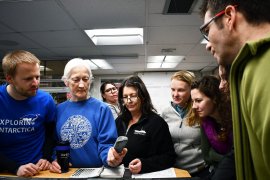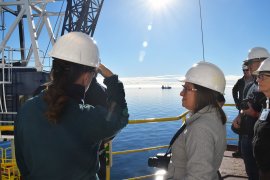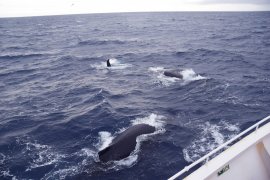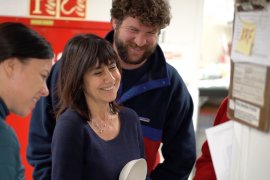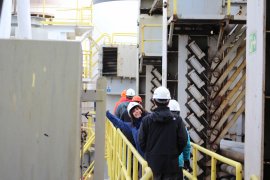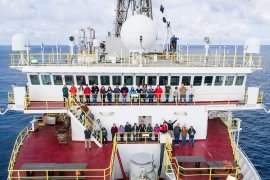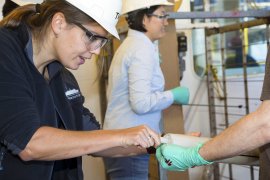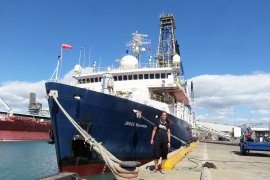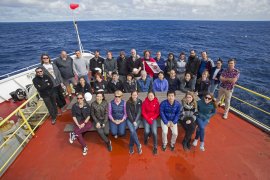International co-operation at its best
Utrecht remarkably well-represented in global ocean drilling expeditions
They are the most prestigious oceanic drilling expeditions imaginable in the earth sciences field: those of the International Ocean Discovery Program, or IODP. Over the past two years, three earth scientists from Utrecht University have sailed with one of the IODP research vessels, the JOIDES Resolution. A remarkably high level of representation, especially since all three are in the same research group. Francesca Sangiorgi, Frida Hoem and Marlow Cramwinckel talk about their experiences.
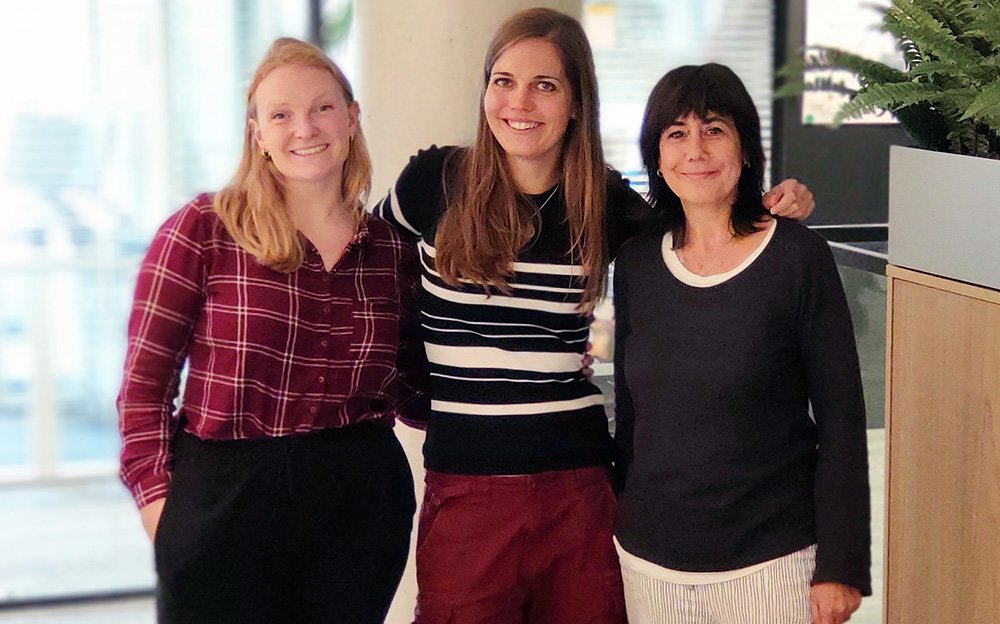
The history of the Earth lies hidden in the sediments below the seabed. Each layer of sediment is like a page of the history book, so by drilling deep down through the sediments we can read the story page by page. The IODP is an international marine research collaboration programme established to investigate the history, climate, deep biosphere and dynamics of the Earth.
With the help of two gigantic drilling vessels and other research platforms, scientists from all over the world extract sediment cores from beneath the ocean floor. These are sometimes hundreds of metres long. The drill string is designed to penetrate five kilometres of water and then another kilometre below the seabed. In total, that is the equivalent of twenty Eiffel towers stacked one on top of the other. The JOIDES Resolution is one of the IODP’s drilling vessels: a 146-metre ship with a hole in the middle of its hull through which a drill string can be lowered from a 60-metre derrick. Frida Hoem, Francesca Sangiorgi and Marlow Cramwinckel from Utrecht University's Marine Palynology and Palaeoceanography research group each sailed separately on the vessel for two months.
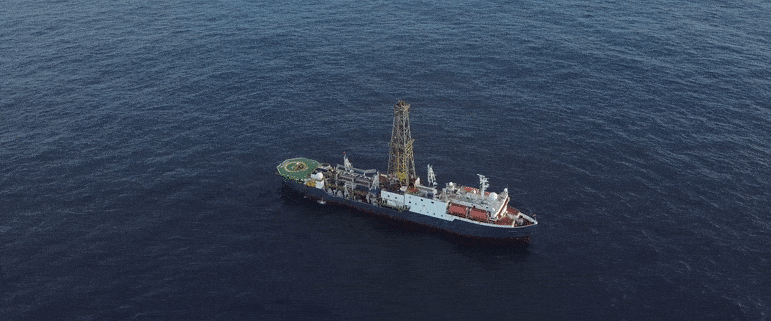
Drone images of the JOIDES Resolution. Video: Adam Kurtz.
A common goal
“You can best compare the JOIDES Resolution with the International Space Station,” says Frida Hoem. The Norwegian earth scientist obtained her Master’s degree in Bergen and came to the Netherlands two years ago to work on her PhD. She is investigating the interaction between ocean, ice and climate in Antarctica. This spring she spent more than two months in the Southern Ocean, between the southernmost tip of Chile and Antarctica. “Researchers from all over the world come together on the ship,” she explains. “Everyone has a different scientific background, but all have a common goal.” Hoem was part of Expedition 382, or ‘Expedition Iceberg Alley’, a voyage to determine the dynamics of the Antarctic ice sheets during the past 15 million years and to reconstruct what oceanographic changes were associated with climate variability in the Southern Ocean during that period.
The perfect moment
“I felt a real mix of emotions when I heard I could join one IODP Expedition,” admits Francesca Sangiorgi. “I’m very prone to seasickness, and I have two children who I wouldn’t see for two months. But I also thought it was really cool!” Sangiorgi is one of Hoem’s PhD supervisors. In early 2018 she sailed to the Ross Sea near Antarctica, far to the south of Australia and New Zealand.
The seasickness did not hold her back, because the expedition was heading for the perfect place at the perfect time for Sangiorgi to drill the cores for her research. “I am a marine palynologist,” she explains, “which means that I analyse fossil remains of marine micro-organisms in sediments to make reconstructions of the climate centuries to millions of years ago. For a decade now, I’ve been working to reconstruct what the Antarctic climate and the oceanography of the Southern Ocean were like during the warmest periods of the past 20 million years. The climate then was very similar to that predicted for the end of this century. We want to build a better picture of the future behaviour of the Antarctic ice sheets, because if they melt global sea level will rise by 55 metres.”
“I’d already worked on other international projects such as ANDRILL and IODP Expedition 318,” Sangiorgi continues. “But they concentrated more on understanding the dynamics of the largest Eastern Antarctic ice sheet. Expedition 374, dubbed ‘Expedition Ross Sea Western Antarctic Ice Sheet History’, focused upon the smallest ice sheet in the Western Antarctic, which would ‘only’ raise the sea level by seven metres. But it’s more sensitive to warm seawater as it mostly lies below sea level, and is already melting fast. I needed samples for my research from that location in the Ross Sea. In turn, the IODP expedition needed my expertise.”
Setbacks
Marlow Cramwinckel, also a palynologist, interjects. “Of course, things don’t always go as planned during that kind of expedition. You have to be flexible.” Cramwinckel was the first of the three to sail on the JOIDES Resolution. They obtained her PhD this spring, for their reconstructions of the climate 40 million years ago. That was a period in which the Earth was warming, just as it is now, although many times slower than today. We can use data from that time to better understand global warming. As part of Expedition 371, the ‘Tasman Frontier Expedition’, Cramwinckel sailed across the Tasman Sea between Australia and New Zealand two years ago to recover fossil plankton from the seabed. This was not always easy. “Every time we came close to layers of sediment about 40 million years old, something went wrong,” they say. “Either there were no fossils or those specific layers were missing. So I ended focusing mainly upon the bigger story during that expedition.”
A new piece of the puzzle
That broader approach, however, was rewarded. The area Cramwinckel sailed to is also known as the ‘lost continent of Zealandia’. It is a piece of continental crust now mostly sunk more than a kilometre below the Tasman Sea. Its only surviving traces above sea level are New Zealand and New Caledonia. “We found fossil pollen and spores deep in our drill cores,” says Cramwinckel. “And also coastal plankton. That is material from land and shallow seas, which indicates that Zealandia was a lot higher then, than it is now. We already suspected that, but we found a new piece of the puzzle. That was a major highlight for me and everyone on board.”
Respect
Hoem's best memory of her voyage is the amount of knowledge present on the ship and how respectfully everyone treated each other. “When a drill core was being brought up,” she says, “it was announced all over the ship and everyone rushed into position, to each carry out their specialised skill to learn more about the fresh material. When we temporarily had less of our own work to do, we helped each other with analyses. Every two weeks we all met up to share what we had discovered, and wrote reports together. I was seen as an expert in my field, even by established scientists. There was little hierarchy on the ship.”
A well-oiled machine
Sangiorgi is inquisitive by nature, a trait she says the expedition only stimulated. “I found it really special that we were the first people in the world ever to see what came out of a specific piece of seabed. No one had ever seen it before. Once a drill core was on board, everybody worked hard and the first research results arrived in no time. The JOIDES Resolution has the most advanced lab you could think of for a ship. And with 130 people aboard, of whom only 30 scientists, it really is a well-oiled machine. By the time we returned to the port, a research report with initial results had already been written. It was international co-operation at its best.”
The amount of scientists from one specific country allowed on an expedition depends on their nation’s financial contribution to it. The IODP-expeditions are funded mainly by the United States and Japan. Fourteen European countries and Canada also participate through the ECORD consortium, but its payments are far more modest: less than a quarter of the total. About thirty scientists can take part in each expedition, which means only a handful of Europeans at a time. The Netherlands contributes three per cent to the European budget, through the Netherlands Organisation for Scientific Research (NWO); so on paper this would amount to a total entitlement of seven participants over the past five years. In fact, there have been nine. All of which makes it really special that three Utrecht earth scientists have sailed with the JOIDES Resolution over the past two years.


